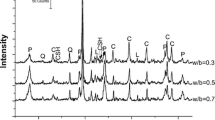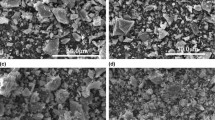Abstract
Steel slag inhibits the early hydration of cement, which limits its applications in cement-based materials. In this study, steel slag was used to prepare hydraulic lime, and steel slag was found to promote hydration in the hydraulic lime during the induction stage and inhibited hydration in the acceleration stage. As the steel slag content increased, hydration of hydraulic lime slowed and the yields of the hydration products C-S-H and Ca(OH)2 decreased. The pore sizes of steel slag-hydraulic lime pastes were principally distributed in the range of 100–4000 nm. Hydraulic lime with a steel slag content of 10% had the highest peak heat release rate during the acceleration stage. When the steel slag content was 10%, the porosity of the matrix decreased, the compactness increased, and the three- and seven-day compressive strengths of the hardened paste also increased in comparison to the paste without steel slag.









Similar content being viewed by others
References
Zhuang S, Wang Q (2021) Inhibition mechanisms of steel slag on the early-age hydration of cement. Cem Concr Res 140:106283
Jia R, Liu J, Jia R (2017) A study of factors that influence the hydration activity of mono-component CaO and bi-component CaO/Ca2Fe2O5 systems. Cem Concr Res 91:123–132
Zareei SA, Ameri F, Bahrami N, Shoaei P, Moosaei HR, Salemi N (2019) Performance of sustainable high strength concrete with basic oxygen steel-making (BOS) slag and nano-silica. J Build Eng 25:100791
World Steel Association (2018) Fact sheet on co-products. In: WorldsteelOrg, vol 2
Zhao Y, Wu P, Qiu J, Guo Z, Tian Y, Sun X, Gu X (2022) Recycling hazardous steel slag after thermal treatment to produce a binder for cemented paste backfill. Powder Technol 395:652–662
Dong Q, Wang G, Chen X, Tan J, Gu X (2021) Recycling of steel slag aggregate in portland cement concrete: an overview. J Clean Prod 282:124447
Li L, Ling TC, Pan SY (2021) Environmental benefit assessment of steel slag utilization and carbonation: a systematic review. Sci Total Environ 806(Pt 1):150280
Santamaría A, Romera JM, Marcos I, Revilla-Cuesta V, Ortega-López V (2022) Shear strength assessment of reinforced concrete components containing EAF steel slag aggregates. J Build Eng 46:103730
Martins ACP, Franco de Carvalho JM, Costa LCB, Andrade HD, de Melo TV, Ribeiro JCL, Pedroti LG, Peixoto RAF (2021) Steel slags in cement-based composites: an ultimate review on characterization, applications and performance. Constr Build Mater 291:123265
Zhang T, Yu Q, Wei J, Li J, Zhang P (2011) Preparation of high performance blended cements and reclamation of iron concentrate from basic oxygen furnace steel slag. Resour Conserv Recycl 56(1):48–55
Muhmood L, Vitta S, Venkateswaran D (2009) Cementitious and pozzolanic behavior of electric arc furnace steel slags. Cem Concr Res 39(2):102–109
Li J, Yu Q, Wei J, Zhang T (2011) Structural characteristics and hydration kinetics of modified steel slag. Cem Concr Res 41(3):324–329
Zhang T, Zhang H, Dai S, Huang D, Wang W (2021) Variation of viscosity and crystallization properties of synthetic ferronickel waste slag with Al2O3 content. Ceram Int 47(16):22918–22923
Fang K, Wang D, Zhao J, Zhang M (2021) Utilization of ladle furnace slag as cement partial replacement: influences on the hydration and hardening properties of cement. Constr Build Mater 299:124265
Qian GR, Suna DD (2002) Autoclave properties of kirschsteinite-based steel slag. Cem Concr Res 32(9):1377–1382
Shi CJ, Hu SF (2003) Cementitious properties of ladle slag fines under autoclave curing conditions. Cem Concr Res 33(11):1851–1856
Wang Q, Yan P, Feng J (2011) A discussion on improving hydration activity of steel slag by altering its mineral compositions. J Hazard Mater 186:1070–1075
Murri AN, Rickard WDA, Bignozzi MC, Riessen AV (2013) High temperature behaviour of ambient cured alkali-activated materials based on ladle slag. Cem Concr Res 43:51–61
Qiana G, Sun DD, Tay JH, Lai Z, Xu G (2002) Autoclave properties of kirschsteinitebased steel slag. Cem Concr Res 32:1377–1382
Shi Y, Chen HY, Wang J, Feng QM (2015) Preliminary investigation on the pozzolanic activity of superfine steel slag. Constr Build Mater 82:227–234
Wang Q, Yang JW, Yan PY (2013) Cementitious properties of super-fine steel slag. Powder Technol 245:35–39
Zhu H, Ma M, He X, Zheng Z, Su Y, Yang J, Zhao H (2021) Effect of wet-grinding steel slag on the properties of Portland cement: an activated method and rheology analysis. Constr Build Mater 286:122823
Pontikes Y, Kriskova L, Cizer Ö, Jones PT, Blanpain B (2013) On a new hydraulic binder from stainless steel converter slag. Adv Cem Res 25:2–31
Salman M, Cizer Ö, Pontikes Y, Snellings R, Vandewalle L, Blanpain B, Van Balen K (2015) Cementitious binders from activated stainless steel refining slag and the effect of alkali solutions. J Hazard Mater 286:21–219
Wang S, Yu L, Huang L, Wu K, Yang Z (2021) Incorporating steel slag in the production of high heat resistant FA based geopolymer paste via pressure molding. J Clean Prod 325:129265
Lu T-H, Chen Y-L, Shih P-H, Chang J-E (2018) Use of basic oxygen furnace slag fines in the production of cementitious mortars and the effects on mortar expansion. Constr Build Mater 167:768–774
Huo B, Li B, Huang S, Chen C, Zhang Y, Banthia N (2020) Hydration and soundness properties of phosphoric acid modified steel slag powder. Constr Build Mater 254:119319
Zhang H, Zhang XY (2019) Preparation of modified porous steel slag/rubber composite materials and its properties. Chin J Eng 41:88–95
Callebaut K, Elsen J, Balen KV et al (2001) Nineteenth century hydraulic restoration mortars in the Saint Michael’s Church (Leuven, Belgium): natural hydraulic lime or cement. Cem Concr Res 31(3):397–403
Válek J, Halem EV, Viani A, Pérez-Estébanez M, Ševčík R, Šašek P (2014) Determination of optimal burning temperature ranges for production of natural hydraulic limes. Constr Build Mater 66(1):771–780
Luo K, Li J, Lu Z, Wang L, Deng X, Hou L, Jiang J (2021) Preparation and performances of foamed hydraulic lime. Constr Build Mater 290:123244
EN BS 459–1:2015 (2015) Building lime. Part 1: Definitions, specifications and conformity criteria, Brussels
Shi UC, Qian J (2000) High performance cementing materials from industrial slags a review. Resour Conserv Recycl 29(3):195–207
Zajac M, Skocek J, Lothenbach B, Haha MB (2020) Late hydration kinetics: indications from thermodynamic analysis of pore solution data. Cem Concr Res 129:105975
Srivastava S, Jacklin R, Snellings R, Barker R, Spooren J, Cool P (2022) Experiments and modelling to understand FeCO3 cement formation mechanism: time-evolution of CO2-species, dissolved-Fe, and pH during CO2-induced dissolution of Fe(0). Constr Build Mater 345:128281
Luo K, Lu ZY, Jiang J, Niu Y (2019) Effect of nano-SiO2 on early hydration of natural hydraulic lime. Constr Build Mater 216:119–127
Luo K, Li J, Han Q, Lu ZY, Deng X, Hou L, Niu YH, Jiang J, Xu X, Cai P (2020) Influence of nano-SiO2 and carbonation on the performance of natural hydraulic lime mortars. Constr Build Mater 235:117411
Kong X, Emmerling S, Pakusch J, Rueckel M, Nieberle J (2015) Retardation effect of styrene-acrylate copolymer latexes on cement hydration. Cem Concr Res 75:23–41
Moschner G, Lothenbach B, Figi R, Kretzschmar R (2009) Influence of citric acid on the hydration of Portland cement. Cem Concr Res 39:275–282
Thomas NL, Birchall JD (1983) The retarding action of sugars on cement hydration. Cem Concr Res 13:830–842
Berodier E, Scrivener K (2014) Understanding the filler effect on the nucleation and growth of C-S-H. J Am Ceram Soc 97:3764–3773
Zhou J, Ye G, van Breugel K (2006) Hydration of Portland cement blended with blast furnace slag at early age, In: Marchand J, Bissonnette B, Gagne R, Jolin M, Paradis F (eds), Second international symposium on advances in concrete through science and engineering, Quebec
Acknowledgements
This work was supported by the Natural Science Foundation of Sichuan Province (2022NSFSC1135), Sichuan Science and Technology Program (No.2019ZDZX0024). The authors would like to thank Shu Xiang from Shiyanjia Lab (www.shiyanjia.com) for the language editing service.
Author information
Authors and Affiliations
Corresponding authors
Ethics declarations
Conflict of interest
We declare that we do not have any commercial or associative interest that represents a conflict of interest in connection with the work submitted.
Additional information
Publisher's Note
Springer Nature remains neutral with regard to jurisdictional claims in published maps and institutional affiliations.
Rights and permissions
About this article
Cite this article
Luo, K., Peng, K., Li, J. et al. Effects of steel slag on the early hydration of hydraulic lime. Mater Struct 55, 228 (2022). https://doi.org/10.1617/s11527-022-02063-y
Received:
Accepted:
Published:
DOI: https://doi.org/10.1617/s11527-022-02063-y




